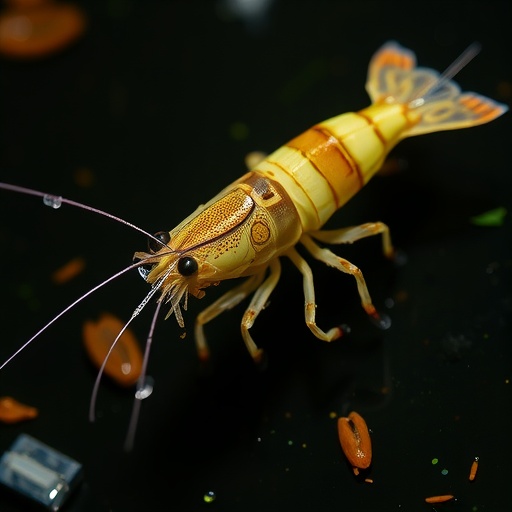In an era where environmental health has become a pressing priority, researchers have turned their attention towards more innovative and effective means of monitoring aquatic ecosystems. Among the various species employed in environmental assessments, shrimp have emerged as a pivotal player in detecting the levels of pollutants in aquatic environments. A recent systematic review by Eslami et al. highlights the potential of shrimp as bioindicators for assessing aquatic pollutants, providing an invaluable perspective on their role in environmental monitoring.
The systematic review explores the diverse methodologies employed in evaluating the effectiveness of shrimp in monitoring aquatic pollution. Through a comprehensive analysis of existing literature, the authors underscore the species’ sensitivity to various pollutants, including metals, organic compounds, and other toxic substances. This sensitivity makes shrimp ideal candidates for biomonitoring, which is crucial for assessing ecological health and the impacts of pollutants on marine life.
Shrimp exhibit unique physiological traits that contribute to their effectiveness as bioindicators. Their biological processes can reflect the health of their surroundings, as they accumulate toxins and pollutants from the water in which they reside. This accumulation allows researchers to gauge the extent of pollution within an aquatic habitat, informing assessments that are critical for conservation efforts. The review highlights several case studies demonstrating how shrimp populations have been directly linked to the presence and concentration of various pollutants.
One of the key advantages of using shrimp as bioindicators is their wide distribution across aquatic environments worldwide. From freshwater streams to coastal marine ecosystems, shrimp are ubiquitous and play a significant role in nutrient cycling and food webs. This broad distribution enhances the relevance of findings derived from shrimp studies, making them applicable to a variety of geographical contexts. Eslami et al. emphasize that the use of a single species for monitoring can streamline research efforts and yield insightful data regarding pollution trends.
The systematic review also addresses the methodological challenges researchers face when employing shrimp in pollution assessment. Variability in environmental conditions, such as water temperature, salinity, and habitat types, can impact shrimp’s responses to pollutants, complicating data interpretation. The authors advocate for standardized protocols in shrimp research to enhance comparability and reproducibility of results. This would contribute to a more cohesive understanding of shrimp as bioindicators across different studies and locations.
As the global community becomes increasingly aware of the dangers posed by aquatic pollution, the role of shrimp expands beyond mere bioindication to encompass broader implications for public health and environmental sustainability. Pollutants in aquatic ecosystems not only threaten marine life but also pose risks to human health through the consumption of contaminated seafood. By identifying pollution hotspots through shrimp monitoring, stakeholders can implement timely interventions to minimize human exposure to harmful substances.
In light of rising pollution levels, the review makes a compelling case for integrating shrimp bioindicators into routine environmental monitoring programs. Policymakers and environmental agencies stand to gain significantly from adopting methodologies that include shrimp in their assessments. The review calls for interdisciplinary collaborations that bridge marine biology with environmental science and public health, ensuring comprehensive strategies to tackle aquatic pollution.
Moreover, the potential for educational outreach surrounding shrimp as bioindicators is immense. Raising awareness about their significance can empower communities to engage in better practices for water conservation and pollution prevention. This local stewardship fosters a deeper connection between society and their surrounding environments, which is crucial for successful conservation efforts.
In conclusion, Eslami et al.’s systematic review sheds light on the unparalleled potential of shrimp as bioindicators for assessing aquatic pollutants. By synthesizing existing research, the authors present a compelling argument for the necessity of recognizing and utilizing shrimp in environmental monitoring. As we continue to face environmental challenges, leveraging the natural capabilities of species like shrimp can pave the way for more effective pollution management strategies.
This systematic approach to studying shrimp not only enhances our understanding of aquatic ecosystems but also emphasizes the importance of protecting them. As we move forward, it is essential to invest in research that not only aims to monitor but also aims to protect our invaluable aquatic resources. The time has come to take action, and shrimp may just lead the way towards a cleaner, healthier environment.
Subject of Research: The potential of shrimp as bioindicators for assessing aquatic pollutants.
Article Title: Shrimp as a potential bioindicator for assessing aquatic pollutants, systematic review.
Article References:
Eslami, A., Akbari-Adergani, B., Akbari, N. et al. Shrimp as a potential bioindicator for assessing aquatic pollutants, systematic review.
Environ Monit Assess 197, 1372 (2025). https://doi.org/10.1007/s10661-025-14846-1
Image Credits: AI Generated
DOI: https://doi.org/10.1007/s10661-025-14846-1
Keywords: Shrimp, bioindicators, aquatic pollutants, environmental monitoring, ecological health, pollution assessment.




